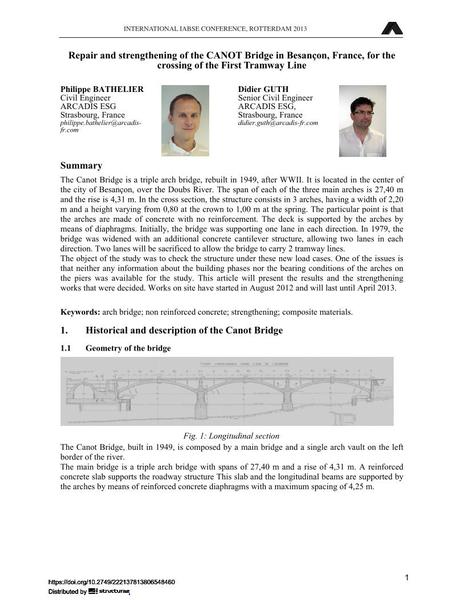Repair and strengthening of the CANOT Bridge in Besançon, France, for the crossing of the First Tramway Line

|
|
|||||||||||
Bibliographic Details
| Author(s): |
Philippe Bathelier
Didier Guth |
||||
|---|---|---|---|---|---|
| Medium: | conference paper | ||||
| Language(s): | English | ||||
| Conference: | IABSE Conference: Assessment, Upgrading and Refurbishment of Infrastructures, Rotterdam, The Netherlands, 6-8 May 2013 | ||||
| Published in: | IABSE Conference, Rotterdam, May 2013 | ||||
|
|||||
| Page(s): | 590-591 | ||||
| Total no. of pages: | 8 | ||||
| Year: | 2013 | ||||
| DOI: | 10.2749/222137813806548460 | ||||
| Abstract: |
The Canot Bridge is a triple arch bridge, rebuilt in 1949, after WWII. It is located in the center of the city of Besançon, over the Doubs River. The span of each of the three main arches is 27,40 m and the rise is 4,31 m. In the cross section, the structure consists in 3 arches, having a width of 2,20 m and a height varying from 0,80 at the crown to 1,00 m at the spring. The particular point is that the arches are made of concrete with no reinforcement. The deck is supported by the arches by means of diaphragms. Initially, the bridge was supporting one lane in each direction. In 1979, the bridge was widened with an additional concrete cantilever structure, allowing two lanes in each direction. Two lanes will be sacrificed to allow the bridge to carry 2 tramway lines. The object of the study was to check the structure under these new load cases. One of the issues is that neither any information about the building phases nor the bearing conditions of the arches on the piers was available for the study. This article will present the results and the strengthening works that were decided. Works on site have started in August 2012 and will last until April 2013. |
||||
| Keywords: |
arch bridge strengthening composite materials non-reinforced concrete non reinforced concrete
|
||||
